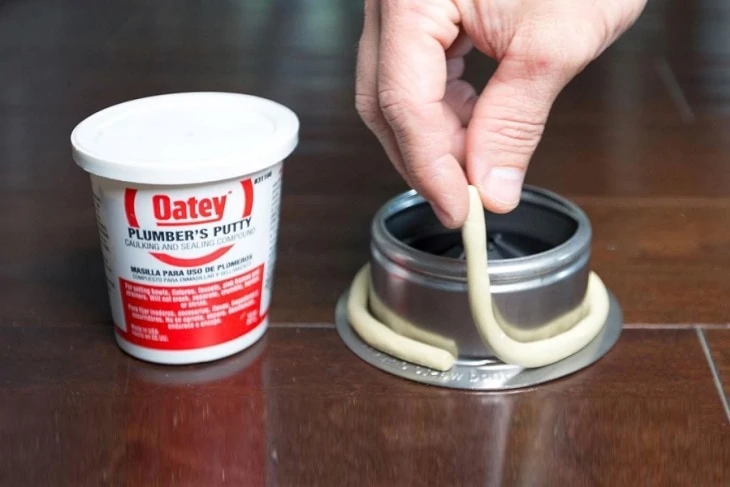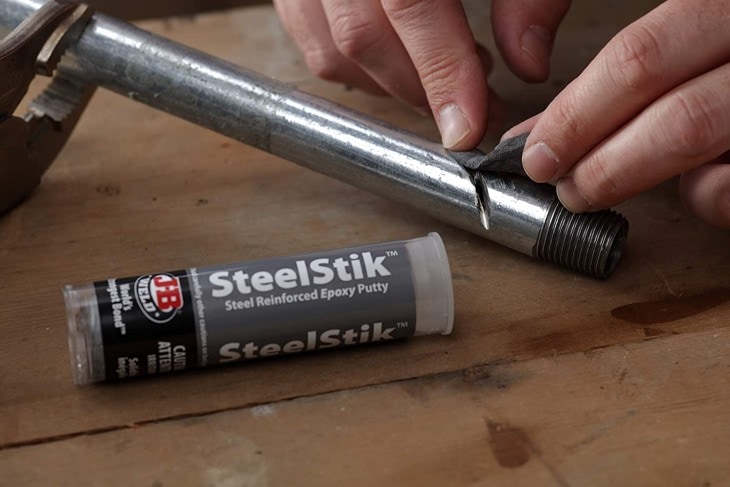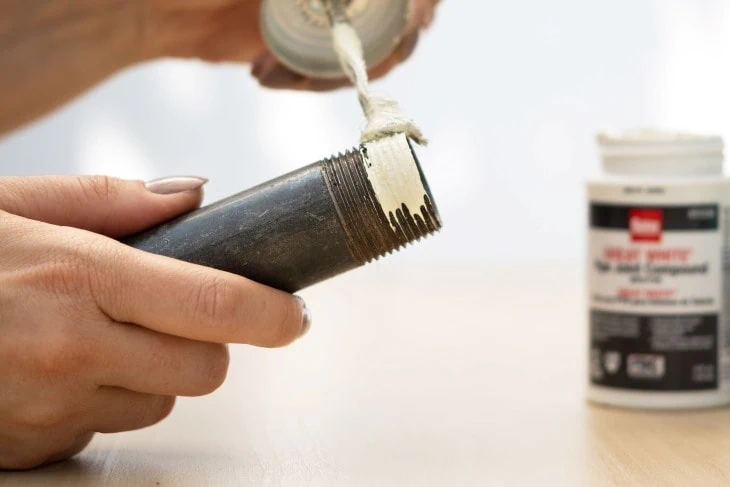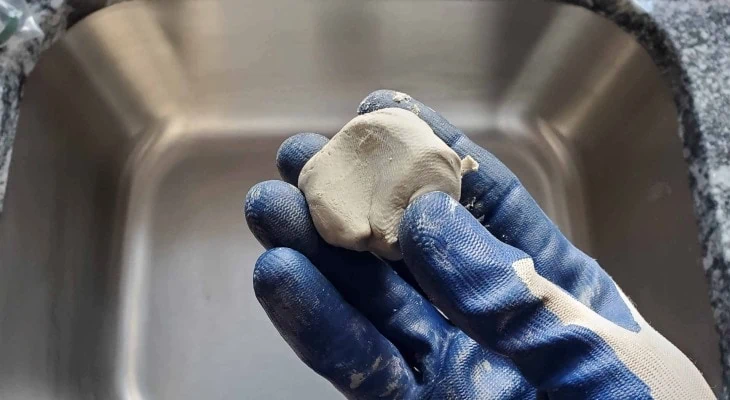Plumber’s putty can be considered a pretty specific and limited product. It is used mainly to connect flanges to another solid surface and prevent water seepage, such as a sink or shower drain.
If you don’t wish to purchase plumber’s putty, thankfully there are a few great alternatives you can use.
It’s not uncommon to decide against using plumber’s putty, but you want to make sure your alternative products can create the same watertight seal that plumber’s putty can. For this, you can use silicone caulk or sealant, epoxy putty, or teflon tape.
Table of Contents
What is Plumber’s Putty?

Plumber’s putty is exactly like it sounds – “putty” used for plumbing fixtures. Fresh out of the container, it’s usually white and has a clay-like feel to it.
It’s important to note that plumber’s putty is not an adhesive, nor is it used to stop existing leaks. Although this may seem like a pain, it is beneficial because it can be easily removed and redone if the need arises.
Why Would You Need an Alternative?
The biggest reason you may opt for an alternative to plumbers putty is that because it’s limited in its use, you may not have it laying around your house at a moment’s notice. But if you find a leak underneath your sink, you may wonder. “What can I use instead of plumber’s putty to fix the issue?”
Check your garage or toolbox for these substitutes. It may save you a trip to the hardware store.
What Can I Use For Non-threaded Fixtures?
The products used for flanges and point-of-contact joints are different from the ones used for threaded joints.
Silicone Sealant
![]()
Silicone is the most popular alternative for plumber’s putty. Not only does it boast superior elasticity, it can withstand higher temperatures and isn’t as prone to cracking as plumber’s putty. It also has antimicrobial properties so it can help prevent the growth of mold.
Another difference, which may or may not be a benefit depending on how you view it, is that it seals with more adhesive properties than plumber’s putty (even though it’s not an adhesive itself). This can make it more difficult to remove, but also longer lasting.
Loctite Silicone Sealant is a very popular option in this category. It can be used straight out of the tube with no preparation. It’s also a bonus that it has other uses besides plumping. It can be used on a multitude of surfaces and materials.
Silicone Caulk
You may be wondering if you can use caulk instead of plumber’s putty and the answer is yes, you can! Just be sure it’s silicone caulk so you can get the malleability and pressure-proof seal that you’ll need.
Liquid Nails Universal Sealant is a popular choice. Used with a caulk gun, it has all the same properties as Loctite, just in a larger package.
It’s commonly used for sealing around glass shower panels and on the bottom of toilets, but can also be used in sink drains in place of plumber’s putty.
Epoxy Putty

Epoxy putty is another suitable alternative to plumber’s putty. It comes in a two-part compound mixture and goes on easily. Epoxy putty dries hard whereas plumber’s putty will still have a “softness” to it after it’s dried.
For this reason, epoxy putty is much harder to remove. More often than not, using epoxy putty will result in a permanent fixture. But unlike plumber’s putty it can withstand water pressure, so it’s usually the product of choice when fixing leaks inside pipes.
IMPORTANT: Since epoxy can be considered a toxic compound, be absolutely sure that any epoxy product you use is WRAS approved. This means that it’s certified to be safe for use in any area in which water may be consumed.
J-B Weld Epoxy Putty Stick is an excellent choice when you’re looking for a plumber’s putty alternative. It is safe for use around potable water and has a fairly quick dry time. You simply mix the two-part formula together to form a putty and mold it around the fixture in question. After it cures, you will have a watertight seal.
Aside from silicone sealants, Loctite also makes epoxy putty sealants that are used in the same way as J-B weld. The process of mixing and applying the two-part compound is the same, and it’s also certified to be safe for drinking water.
For Threaded Joints
If the area of concern is around a threaded joint on a pipe, opt for one of the following alternatives.
Teflon Tape
Sometimes known as plumbers tape or PTFE tape, teflon tape can be used in areas where a plumber’s putty cannot. It’s a viable alternative, especially if your leak is around a threaded joint.
It’s important to note that teflon tape is not recommended for use around drain flanges, but it’s the product of choice for sealing threaded joints in faucets.
They are manufactured in different colors for different uses. White is for water pipes, yellow is gas lines, green is for oxygen, and red is used for larger industrial purposes.
Dixon Valve Tape is a popular teflon tape that has excellent sealant properties. To use it, you need to wrap the threads of a male pipe in a clockwise direction. Then affix the male pipe into the female pipe tightly to create your watertight seal.
Thread Sealant
Most often, pipes leak around the joints of threaded pipes. Either because the pipe has experienced too much pressure or the threads were cross-threaded and not sealed correctly.
Thread sealants fill the spaces between male and female pipe joints, creating water and pressure proof seals. Whereas teflon tape is a solid sealant. They do have quite a long dry time, but it’s worth it to fix that leak for good.
Rectorseal Thread Sealant is a highly rated thread sealant which comes in an easy to use tube. Apply it around the male threads and affix as usual. Allow it to cure completely before subjecting it to any water pressure.
Plumber’s Dope

Plumber’s Dope or Pipe Dope is a little bit different than the other items described. It has the same consistency as plumber’s putty and much like plumber’s putty, it doesn’t harden but instead remains as a paste.
Unlike plumber’s putty, plumber’s dope is used specifically for threaded pipes. The material will shift and ooze in between all the threads ensuring a sufficient seal. It also doesn’t permanently adhere, making it easy to separate the threaded pieces in the future.
Plumber’s Pipe Dope should be used with gloves, as it can get messy. It’s preferred over teflon tape in most instances, especially among professional plumbers and when the pipes in question have a larger diameter.
Final Thoughts
A leaky pipe or insufficient seal can quickly turn into an expensive, messy nightmare. Using the right products around the right joints can seem like a daunting task, thankfully you have some versatile options.
When searching for alternatives to plumber’s putty, be sure to pay attention to whether you need to seal a simple flange or you need to repair an entire threaded joint. With a little research and the right products, you can fix your water leak and prevent it from happening again.

